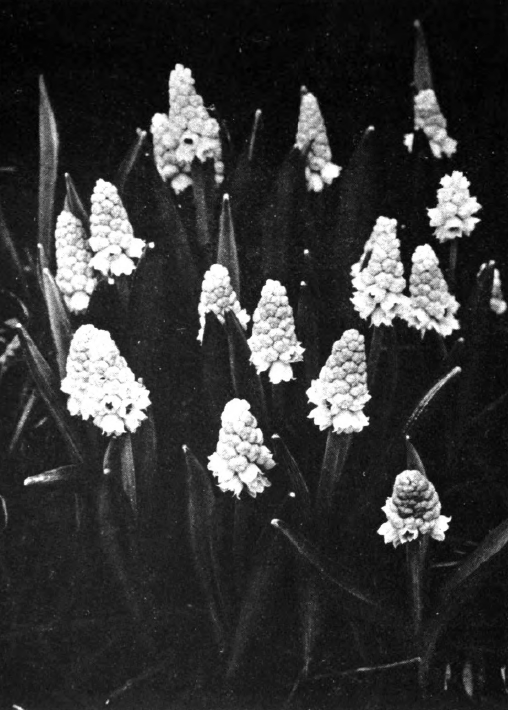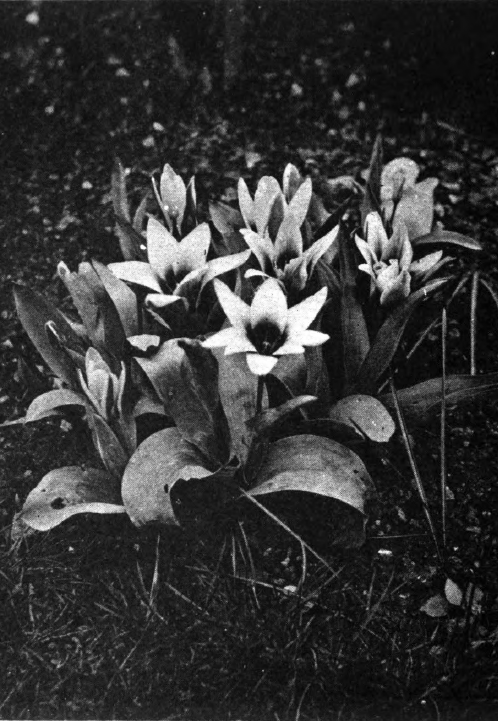| Web
and Book design,
Copyright, Kellscraft Studio 1999-2016 (Return to Web Text-ures) |
 (HOME)
|
|
"The
groundflame of the crocus breaks the mould,
THE CROCUS AND
OTHER EARLY BULBSFair Spring slides hither o'er the Southern sea." TENNYSON. LET me begin by
presenting these
"ruminations," as he calls them, from the pen of the Reverend Joseph
Jacob, of England, whose name is known wherever two or three daffodils
or as
many tulips are gathered together.." Was there ever a time," writes
he, "when bulbs were not popular? Probably not. At all events, there is
not much doubt about it at the present time. Every horticultural firm
which
considers itself at all `up' in the world considers one of its annual
necessities the issuing of a bulb-list. Contrariwise, the reception and
perusal
of these lists are among the perennial pleasures of every one who has a
garden.
Bulbs are wonderfully accommodating things. I have a tortoise which we
call
Timmie, and for the last three months he has been fast asleep under
some nice
dry leaves in the cellar. Just now, with a little careful packing, he
could
very easily undertake a long journey. "Bulbous plants are the
rimmies'
of the vegetable kingdom. When they have retired into their shells,
they can be
sent about so readily and so safely that if they lived to about ten
times the
age of Methuselah, I should not be surprised to find that, if it is
really true
what botanists tell about dispersion and propagation being the two
things that
plants worry themselves most about, then all well-brought-up plantlets
would be
taught, just as we teach the 'three R's' to-day, how to take on a
bulbous state
as an essential part of their life cycle." With Mr. Jacob's
whimsical wish I
heartily agree, more particularly as I recall the few choice aubrietias
by post
from Ireland, the glories in delphinium from England in the same
manner, all of
which, when opened, were found to be exhausted by their journey. Now, before rushing
toward before
leaping to our main flower, the crocus, may I pay a word of tribute to
the
tribe of muscari, the grape hyacinth? While these small bits of
perfection in
flowers, in blue flowers yes, a true blue in some forms are
wonderful in
color, they must, in my experience, be packed closely together in
planting for
any really good effect. While several flowers come from each crocus
bulb set in
earth, from Muscari azureum, the small and early sky-blue, I usually
have but
two, and the tiny things seem not to spread, to multiply, as the crocus
does. Of the other grape
hyacinths, a
delightful color picture is seen each May on either side of my little
brick
walk. The late muscari Heavenly Blue clusters below the pale-yellow
lily-like
heads of Tulipa retrgilexa, and below the grape hyacinth (whose strong
dark-blue has a metallic quality) quantities of fine myosotis plants
are
blooming at the same moment. The earliest muscari are
true crocus
companions azureum in dense companies, with crocus Mont Blanc (cut
facing
page 86) or with such a lavender as Madame Mina a most unusual color
combination may be made. Since the spring of 1912
I have felt
that I must take up my pen for the crocus, to introduce it in a few of
its
newer and less-known varieties to those who have never grown those at
all. The desire to get
"something
for nothing" is quite as noticeable among the guild of amateur
gardeners
as among those who find joy in bargain sales. And in the crocus we have
first
of all a bargain. Thousands for a few dollars, hundreds for some cents.
Next in
cheapness to seeds they are; and have a habit, when not bothered by a
nervous
or too transplanting owner, of multiplying in a fashion comforting to
see. In
the nine years in which I have been growing the crocus on our small
piece of
ground, I cannot now remember having lost any except in cases where the
growth
of overhanging or overhungry shrubbery has eaten up the little things
at its
feet. One of my first plantings
before the
bare east wall of brick of a then new house was of the crocus Reine
Blanche, a
fine white, in groups now dense, now more open, with hosts of Scilla
Sibirica
crowding among them, and that first glory of the tulip family,
Kaufmanniana,
holding outspread back of and above the little blue-and-white multitude
its
lilylike flowers flowers which only open to the sun. Tulipa
Kaufmanniana is
costly, I admit, and growing more so, but, as in the case of Darwin and
May-flowering tulips, many of which are rapidly increasing in value,
delays are
dangerous. Therefore, buy now if possible. I must have often described
it
before its general color within the flower a rich cream, running into
clear
yellow toward the centre of the bloom; on the outside of each petal a
broad
band of dull reddish-rose. To myself I called it a water-lily long
before I
read that it had been often described as the water-lily tulip. In warm
corners
it has opened with me (latitude of Boston) as early as March 25, though
its
usual flowering time in our climate is mid-April. Among the florists'
varieties of
crocus, the one with true magnificence of form and color is Crocus
purpureus,
var. grandiflorus. Magnificent is a large adjective to apply to a
low-growing
flower; ordinarily one should reserve it for the altheas, or the finer
gladioli, sensational in their beauty. But it is a fact that people
unaccustomed to the sight of so large and fine a crocus as this can
sometimes
not be persuaded that it is a crocus; therefore, the word may be
permitted. And
when close-growing numbers of this particular beauty are near other
close
colonies of Scilla Sibirica, there is then a spring effect worth going
far to see.
Maximilian, a clear light-lavender, is a favorite with me. Madame Mina,
white
with rich lavender stripes the length of its fine petals, is a
beauteous
flower; and Reine Blanche, of which mention has just been made, one of
the
loveliest imaginable whites. Mont Blanc, white, is also very fine. In
these
whites, and in Madame Mina as well, the rich orange stigma gives a very
glowing
effect as one looks down into the crocus cup. As for the yellow
crocuses, I
never look at them if I can help it! I have a few remnants of them from
misguided purchases of years gone by, but I am always meaning to clear
them out
and always forgetting to do it till their small squat flowers are gone
and the
track of the position of the bulbs is lost. This antipathy to the
yellow florists'
crocus, which, let me add, does not extend in my case to the yellow of
the
species crocus, may be the prejudice of ignorance, for of varieties
other than
Cloth of Gold and Large Yellow I know nothing. In these the yellow is
the crude
yellow of the dandelion (a flower I hate with all my might)! Mr. E. A.
Bowles,
of Waltham Cross, England, tells us that the more delicate and subtle
tones of
yellow are to be found in several varieties of crocus species; it is to
these
that I plan to turn my attention with great ardor another season. Few of these species
crocus do I
already know in my own borders only half a dozen and as I believe
readers
will rejoice as I have done in some of Mr. Bowles's enthusiastic
comments on or
descriptions of these flowers, I offer no apology for quoting from him,
as I
mention the flowers of which he knows so much, through years of
collecting,
growing, and study. Now, in spite of my
aversion to the
large yellow florists' crocus, I do like Crocus susianus, which is one
of the bright-yellows
before mentioned (Color chart, Cadmium yellow, No. 1). But Crocus
susianus,
blooming as early as April 9, planted very thickly, gave in my border
the
interesting impression of a large-flowering yellow Phlox subulata
practically
no green leaf visible below the masses of bloom. Five to seven flowers
appear
in small, tight bunches from one bulb; and back of and among this
flowering
mass of yellow I had colonies of the white crocus Mont Blanc. Let me
commend
this very simple and unstudied arrangement. C. susianus is much dwarfer
than
Mont Blanc, therefore have it mainly to the front. Crocus Sieberi I call a
warm
pinkish-lavender (Color chart, Violet mauve, No. 1). Six to eight
flowers come
from a bulb, and the bright-orange stigmata within give a glowing
centre to the
little flower. This is very small and low. Mr. Bowles calls it a
"crocus
for every garden" and adds that it "seeds freely and soon spreads in
any sunny border." "Crocus Korolkowi," to
quote Mr. Bowles again, "from the far East, has two good points it
flowers early and is of a peculiarly brilliant form of yellow." This
little crocus I have grown for a few years myself, and it always
surprises me
by appearing practically with the snowdrop. Crocus biflorus, the
"Scotch
crocus," is white, with pencillings of grayish mauve on its three outer
petals. The markings are exquisite and the early blooming of this
crocus marks
it as a specially necessary one. My prime favorite among
all these
species crocus is Crocus Tommasinianus. It is tall, slender, delicate,
with
narrow, pointed petals, of a lovely lavender, slightly bluer than
Sieberi. An
orange pistil within it is like a vivid star. It has great height of
stem, and
tapering form of flower. It is the one which most delights me as a
novice in
crocus-collecting; and last spring, in a limited space where the ground
runs up
into a rather steepish slope for a few feet, which slope is covered by
a thick
group of the little tree known as the garland thorn, there beneath the
small
tree stems I hope to see next spring hundreds of little candles,
lavender
candles of Crocus Tommasinianus running up the tiny hillside, and
racing along
beside them a company of Galanthus Elwesii, their companions in time of
bloom.
"I have found," writes Mr. Bowles, "C. Tommasinianus so far to
prove the most satisfactory of the wild species for spreading and
holding its
own when planted in grass." Several beautiful new
seedling
crocuses have come within a few years from Holland May and Dorothea
the
latter a "soft, pale lavender-mauve," May "a beautiful white of
fine form." These two I have; not, however, Kathleen Par-low, said to
be
an extra-fine white, with wonderful orange anthers, nor Distinction,
the
nearest approach to a pink color in crocus. The beauty of tulip
Kaufmanniana was
never, I fancy, better set forth in a photograph than in that which is
shown on
page 98. To the kindness of Mr. Bowles himself I owe this picture of
perfect
spring loveliness, and to the kindness of the distinguished Scottish
amateur
Mr. S. Arnott the picture of the blue grape hyacinth, Hyacinthus
lineatus
(mums. This flowered in Mr. Arnott's garden in February, 1912, and is,
I
believe, a rare variety. To my eyes it is so
charming a
picture of the type that its inclusion here will surely give pleasure
to those
to whom these "small and early" things are objects of interest.  HYACINTHUS LINEATUS, Var. AZUREUS  TULIP KAUFMANNIANA |